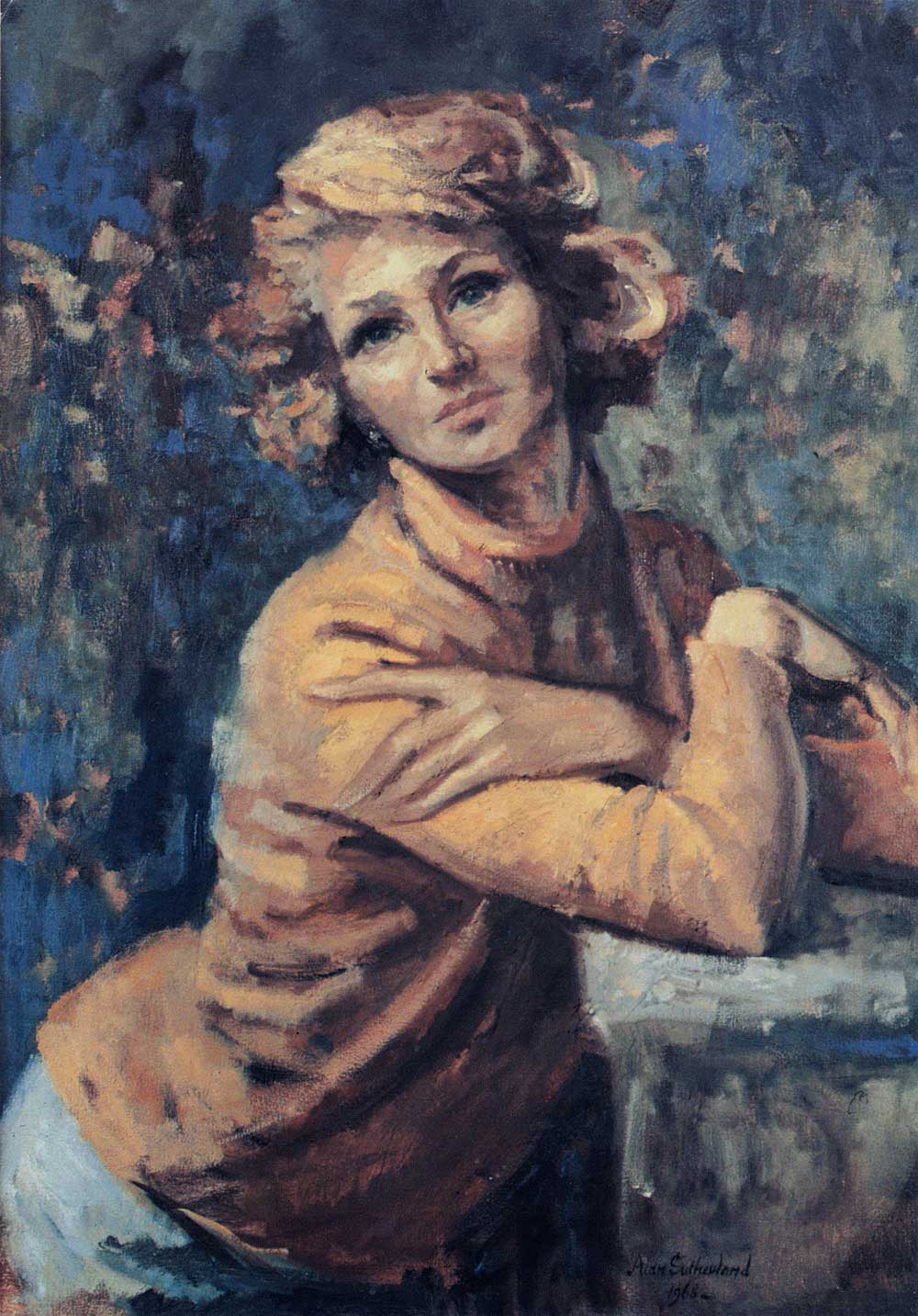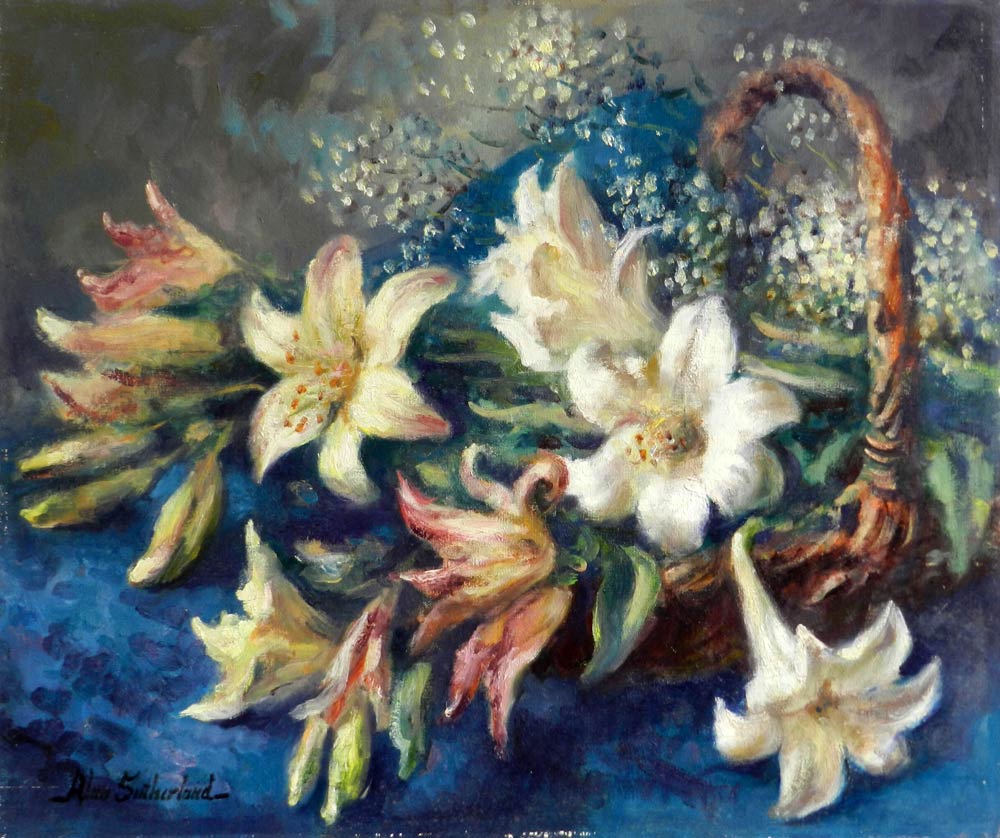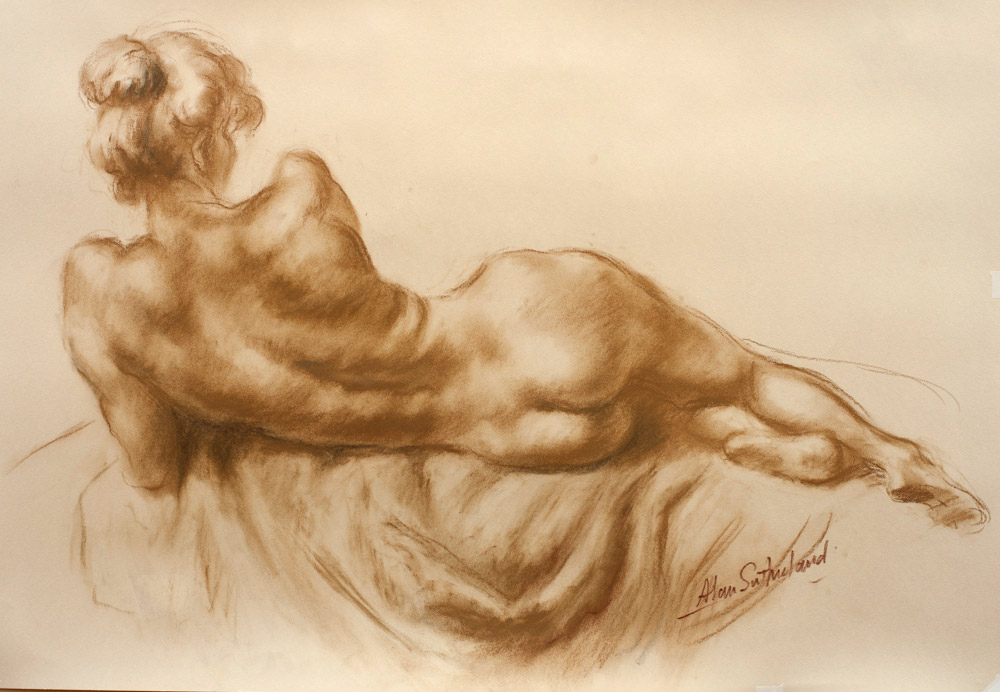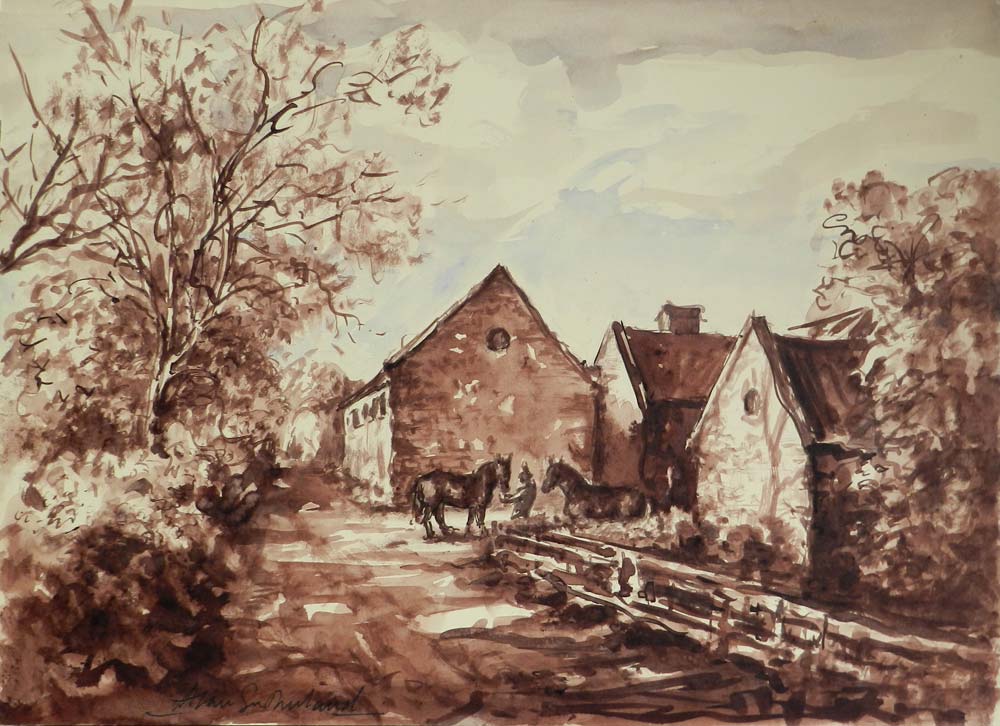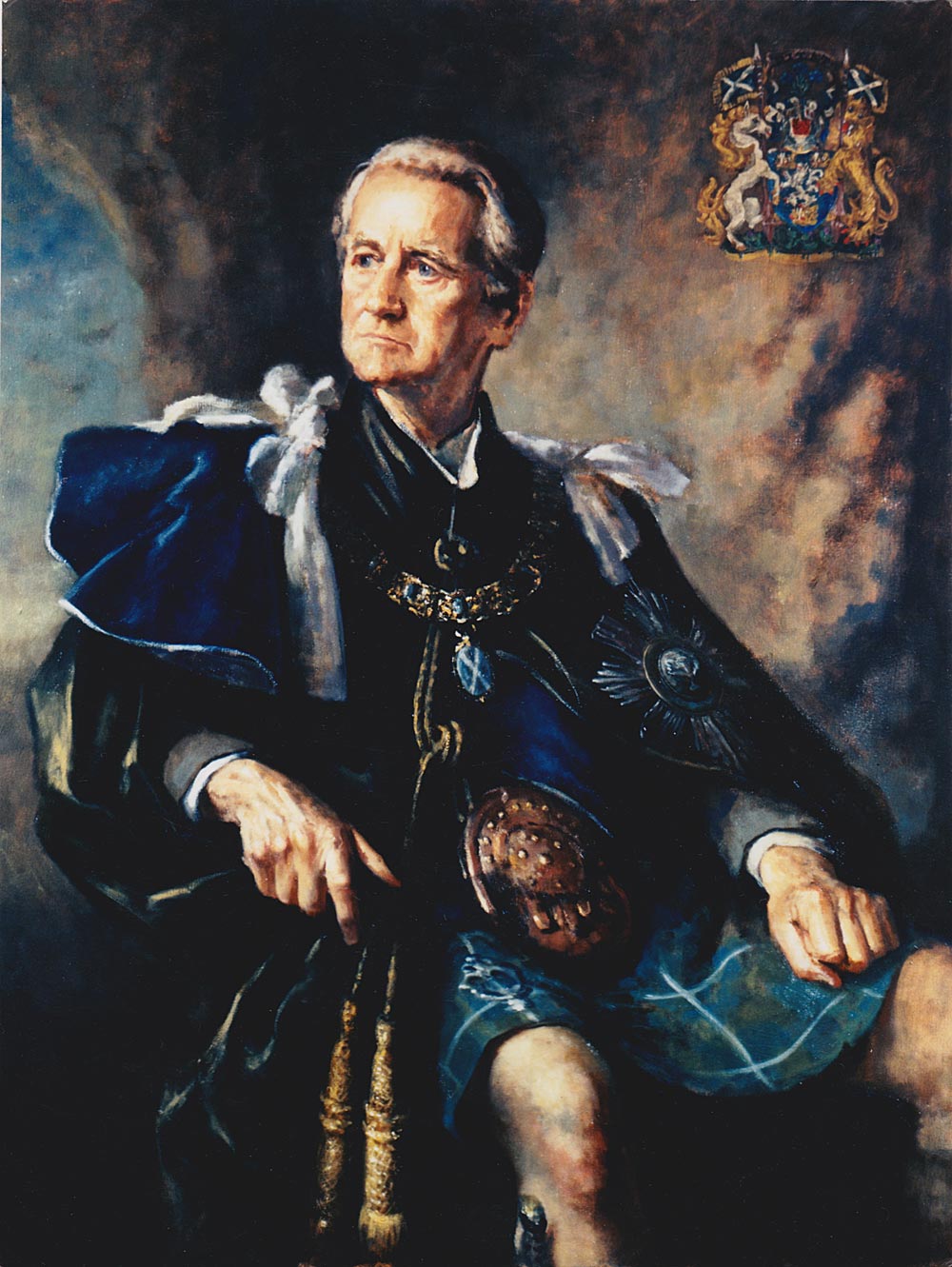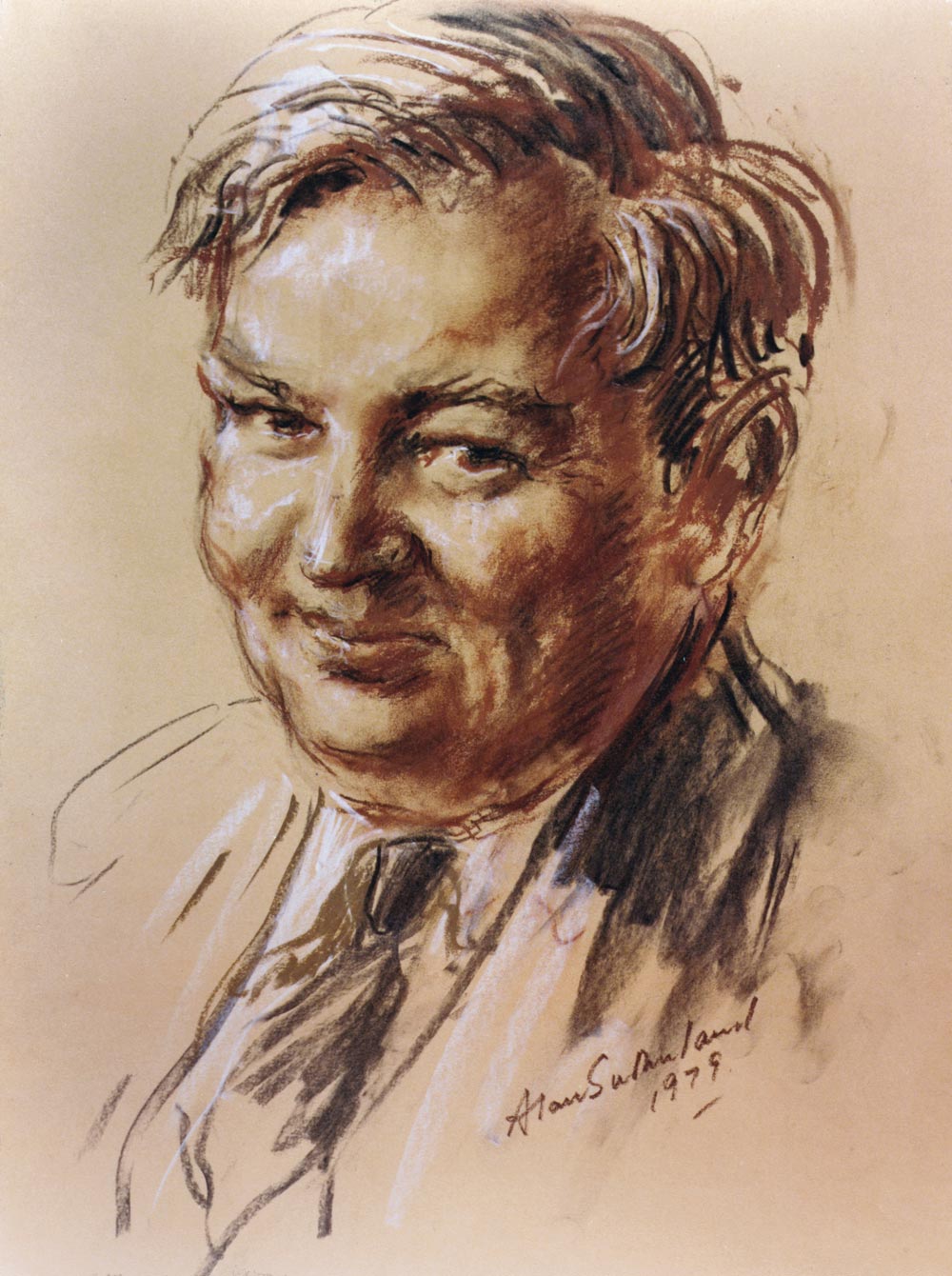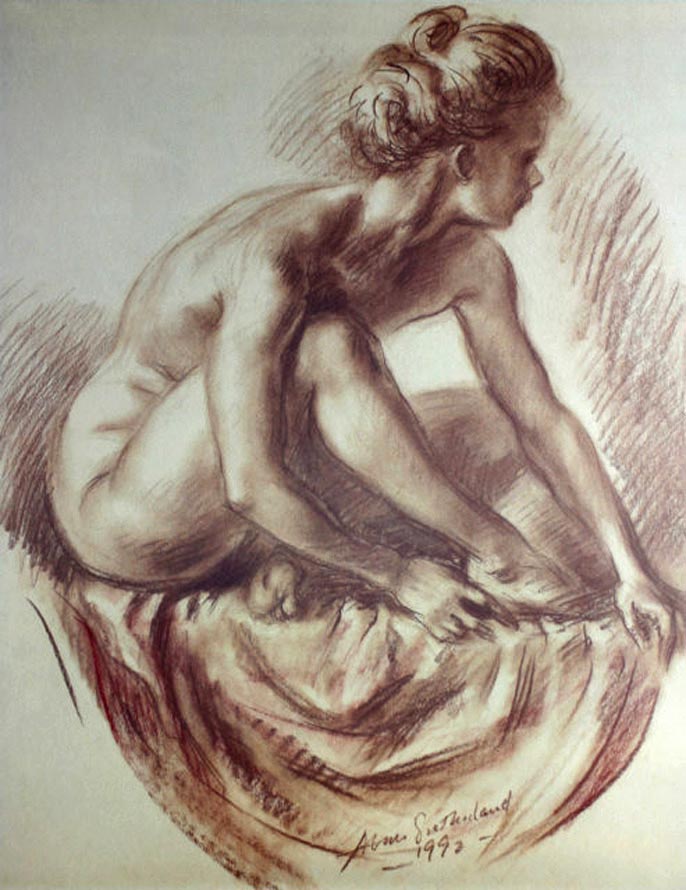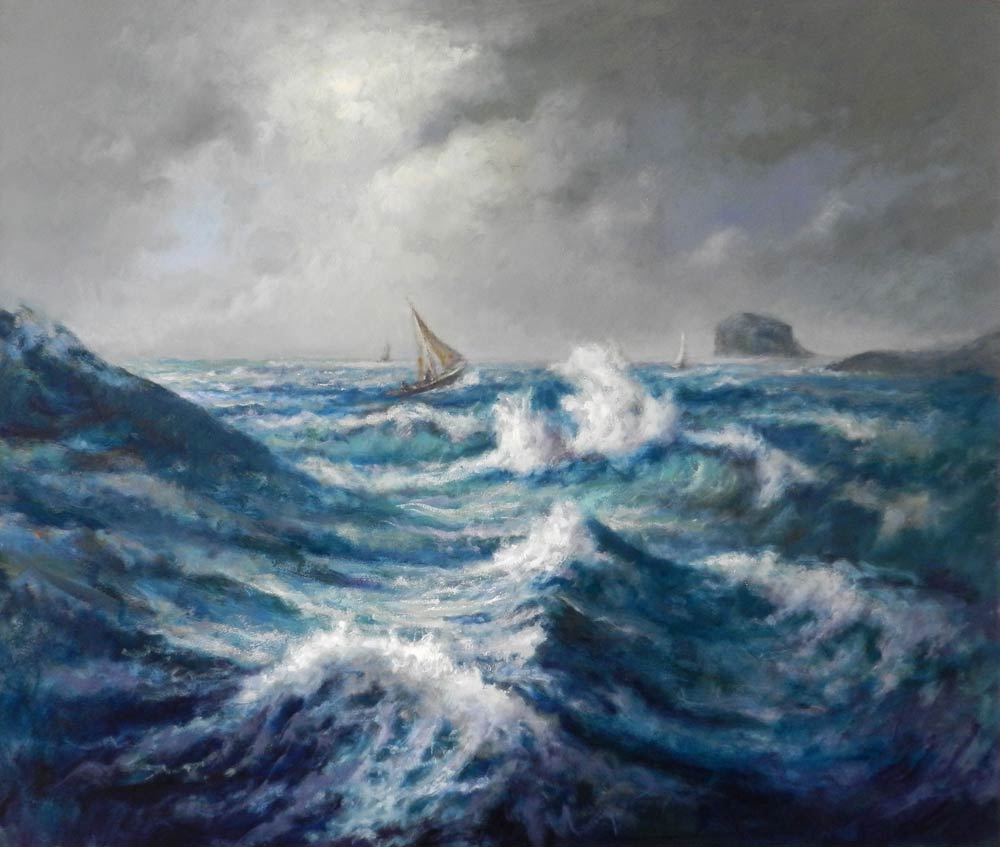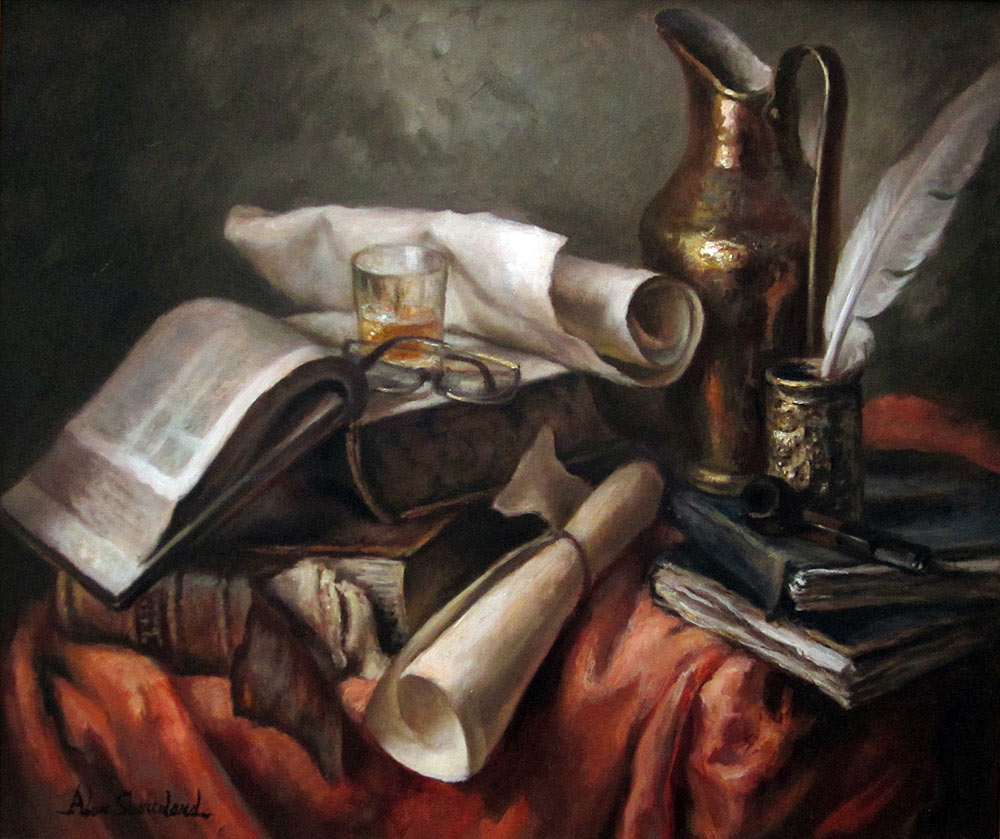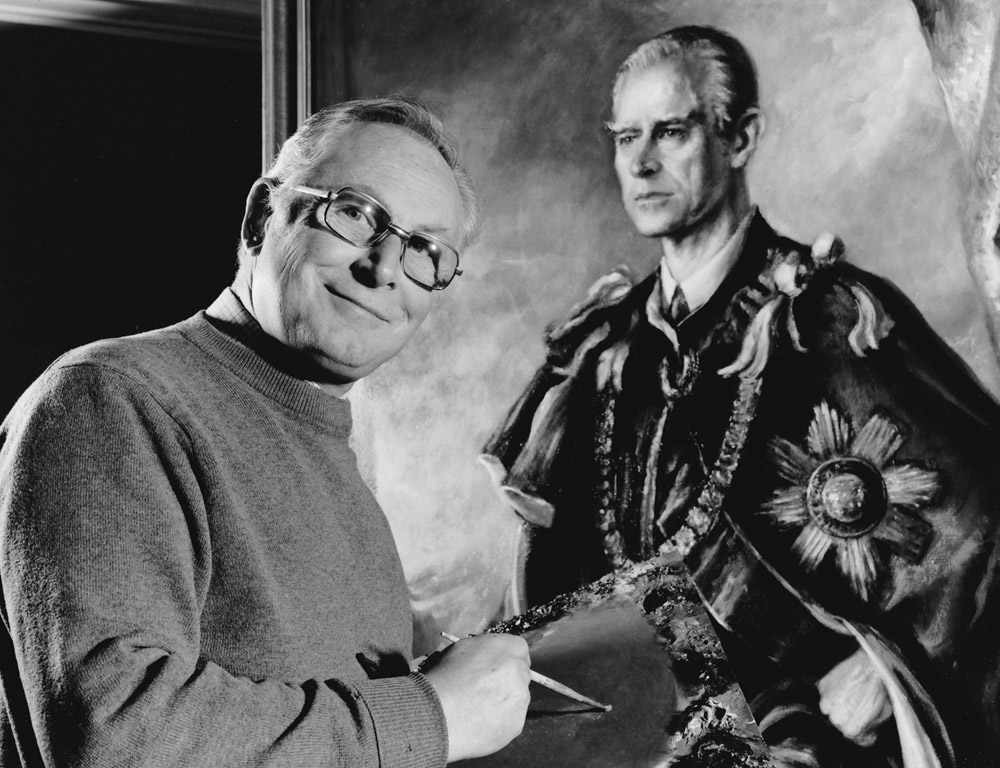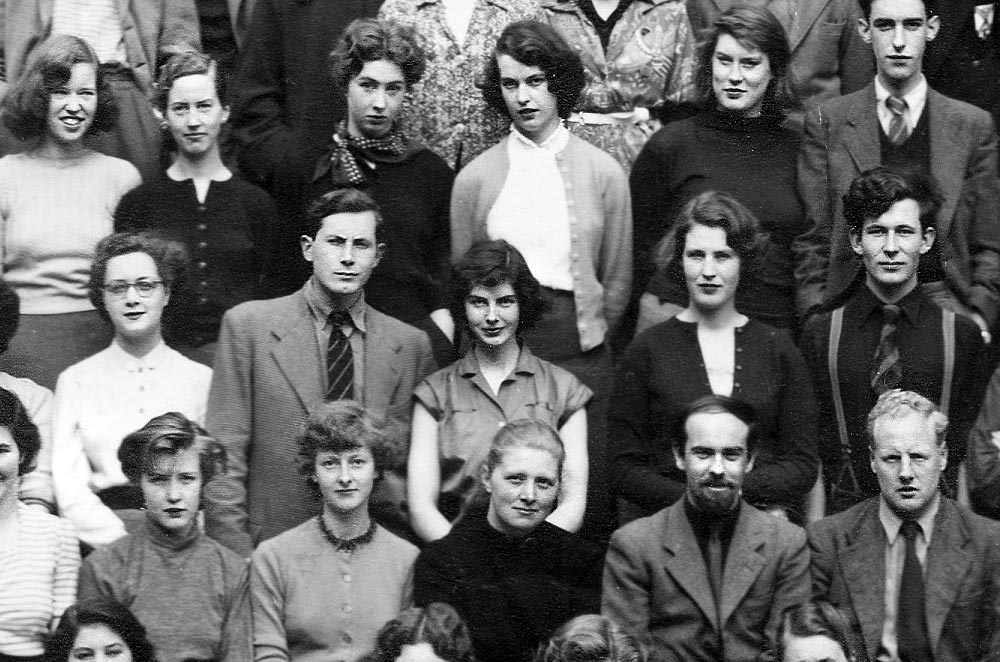 Edinburgh College of Art
Section of Year Photo | 1952
Edinburgh College of Art
Section of Year Photo | 1952
 Exhibition
London | 1958
Exhibition
London | 1958
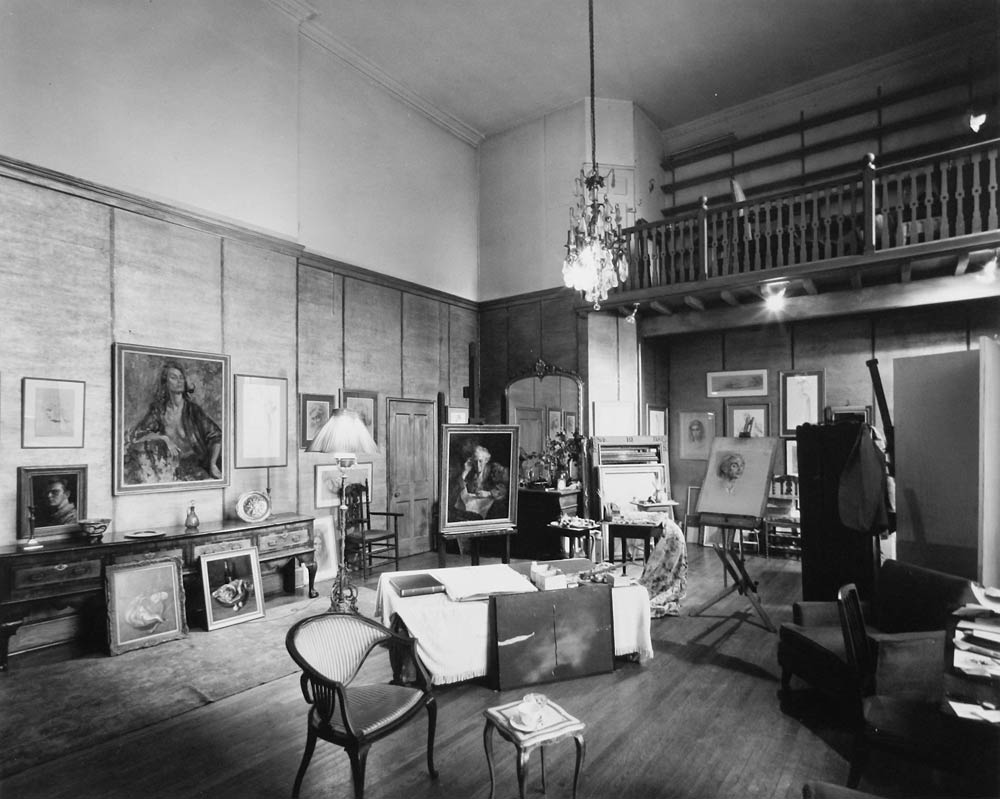 Artist Studio
Cadogan Square, London | 1960
Artist Studio
Cadogan Square, London | 1960
 Artist Studio
Cadogan Square, London | 1960
Artist Studio
Cadogan Square, London | 1960
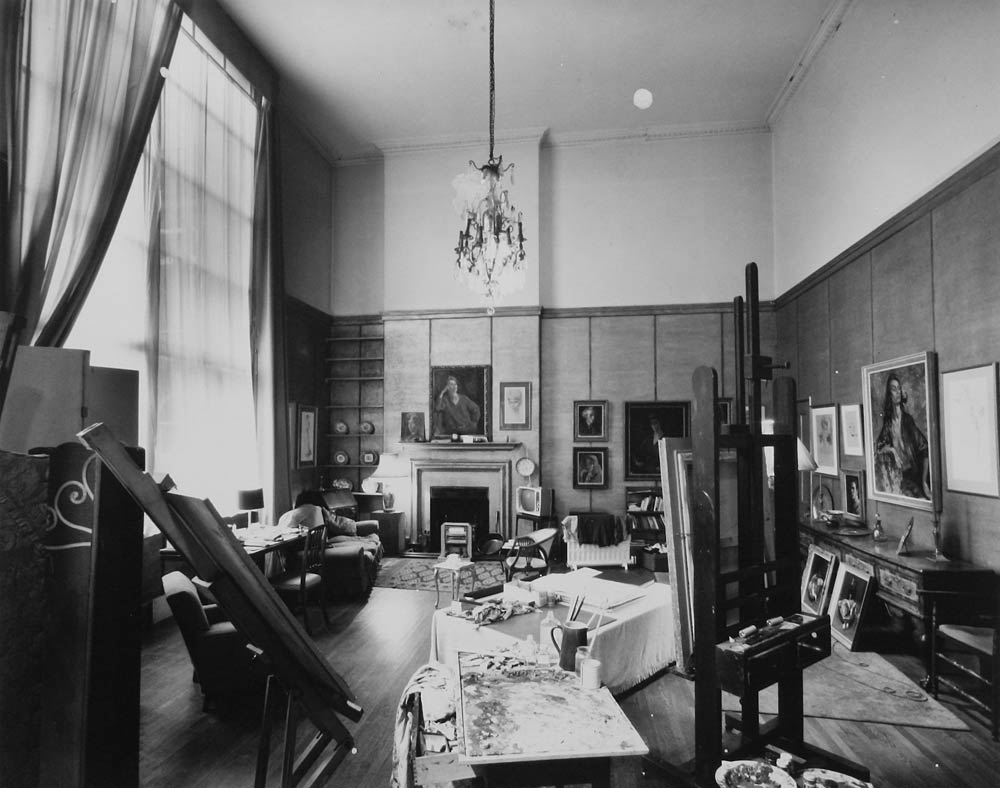 Artist Studio
Cadogan Square, London | 1960
Artist Studio
Cadogan Square, London | 1960
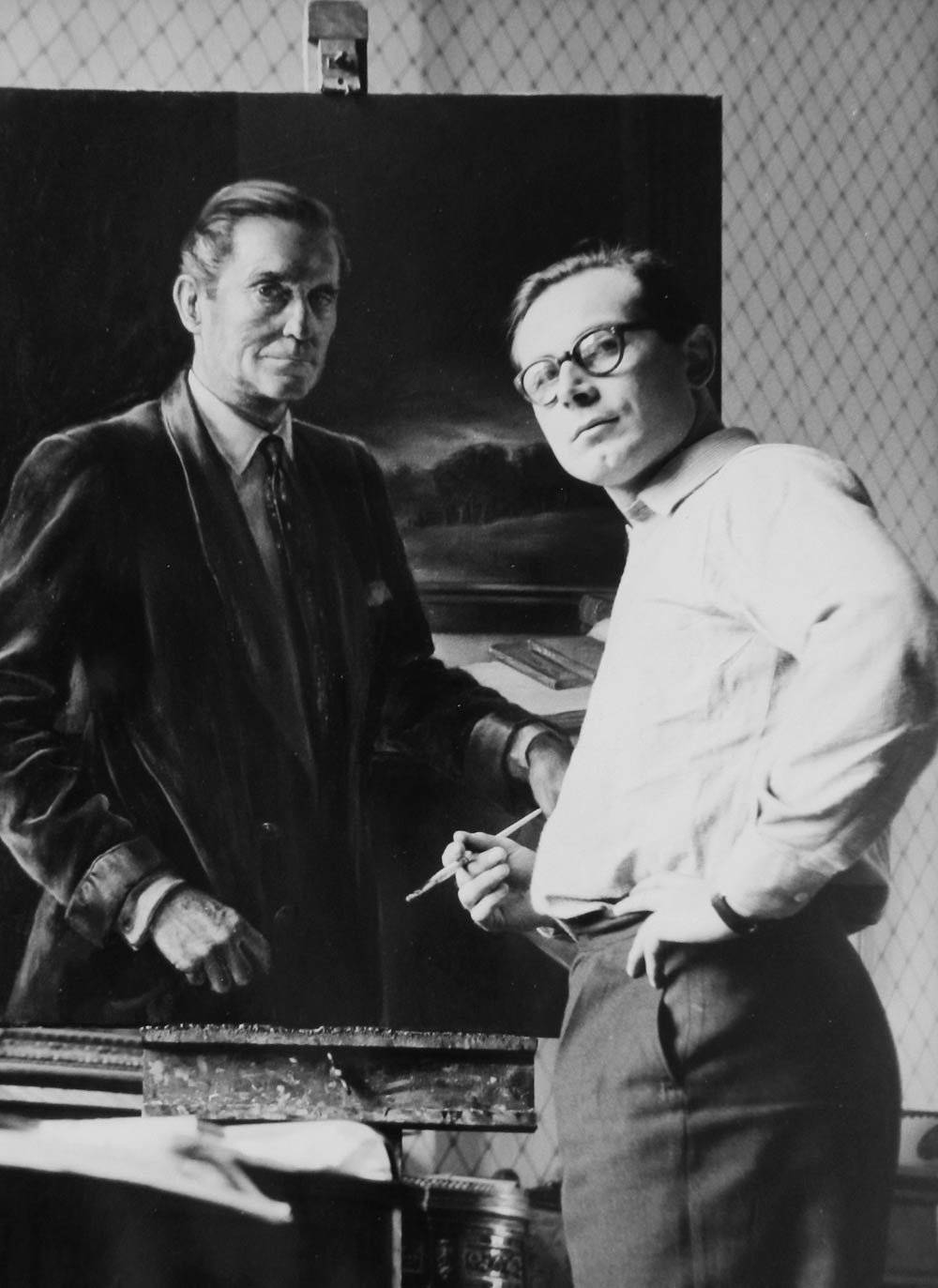 Sixth Marquess of Bath
Bristol | 1961
Sixth Marquess of Bath
Bristol | 1961
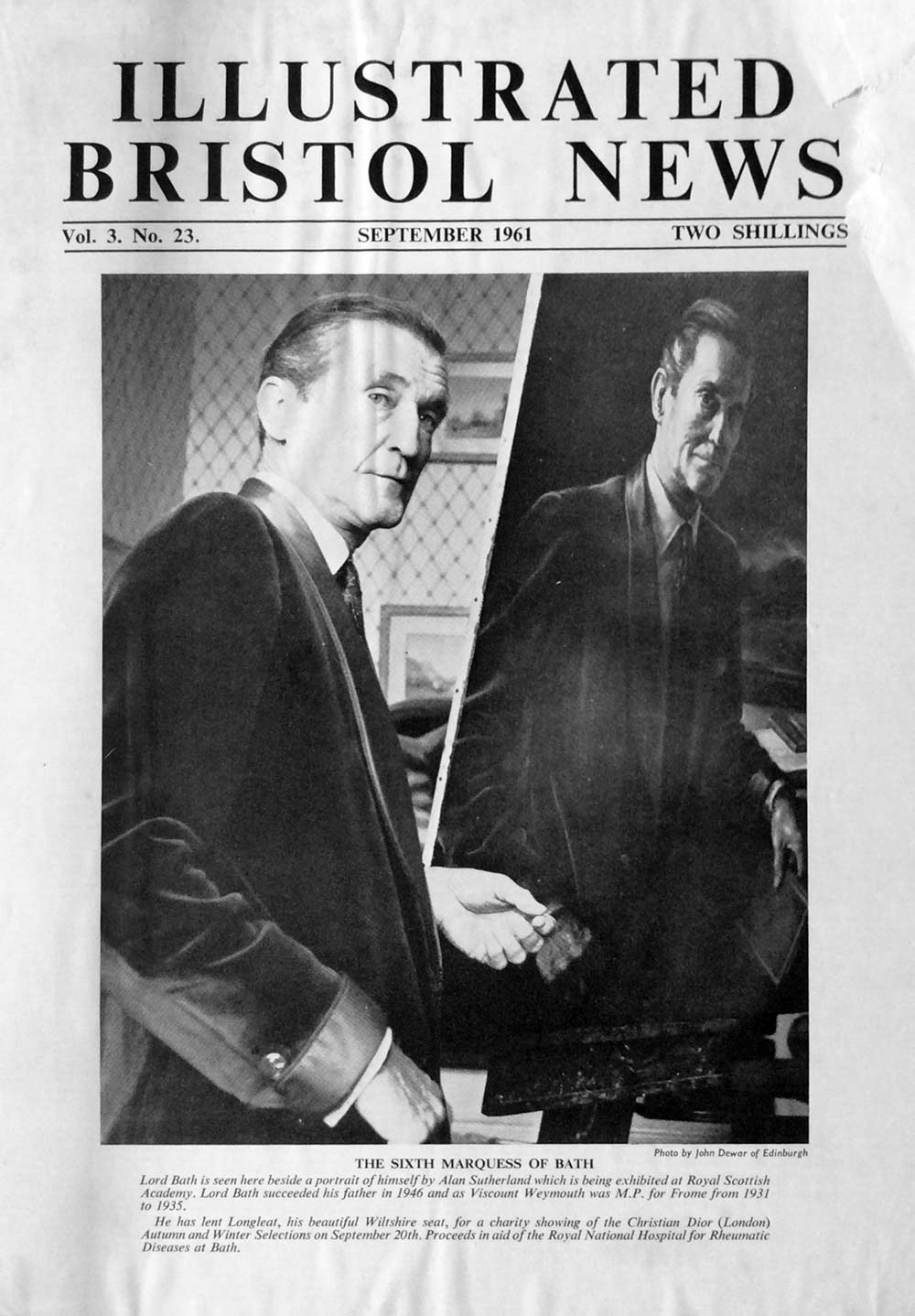 Sixth Marquess of Bath
Illustrated Bristol News | 1961
Sixth Marquess of Bath
Illustrated Bristol News | 1961
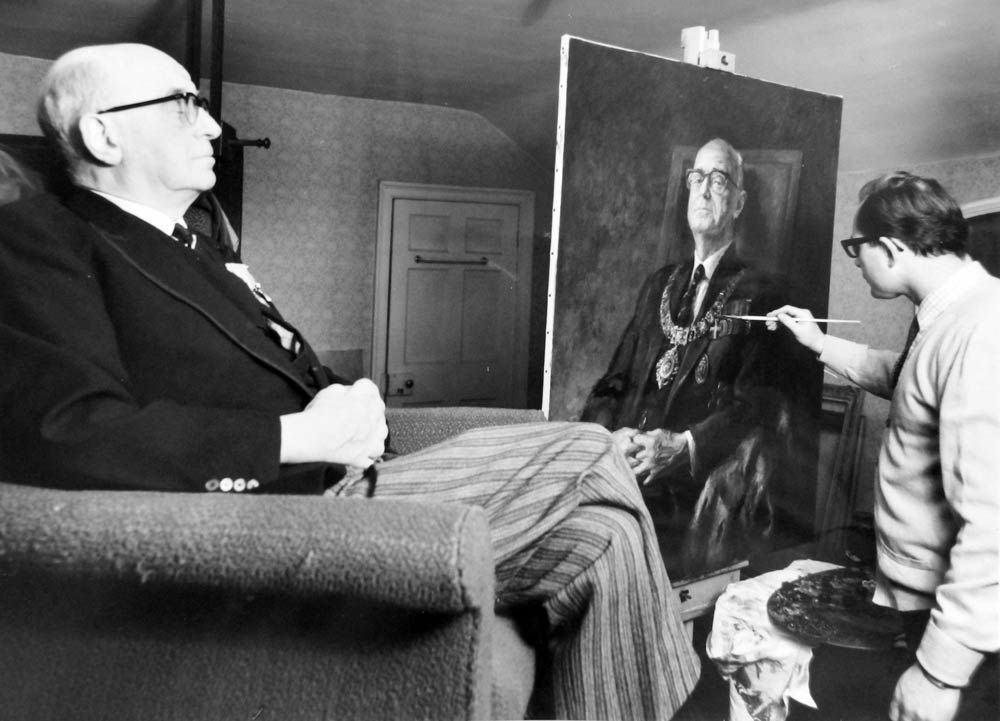 Sir Duncan Weatherstone
Edinburgh | 1969
Sir Duncan Weatherstone
Edinburgh | 1969
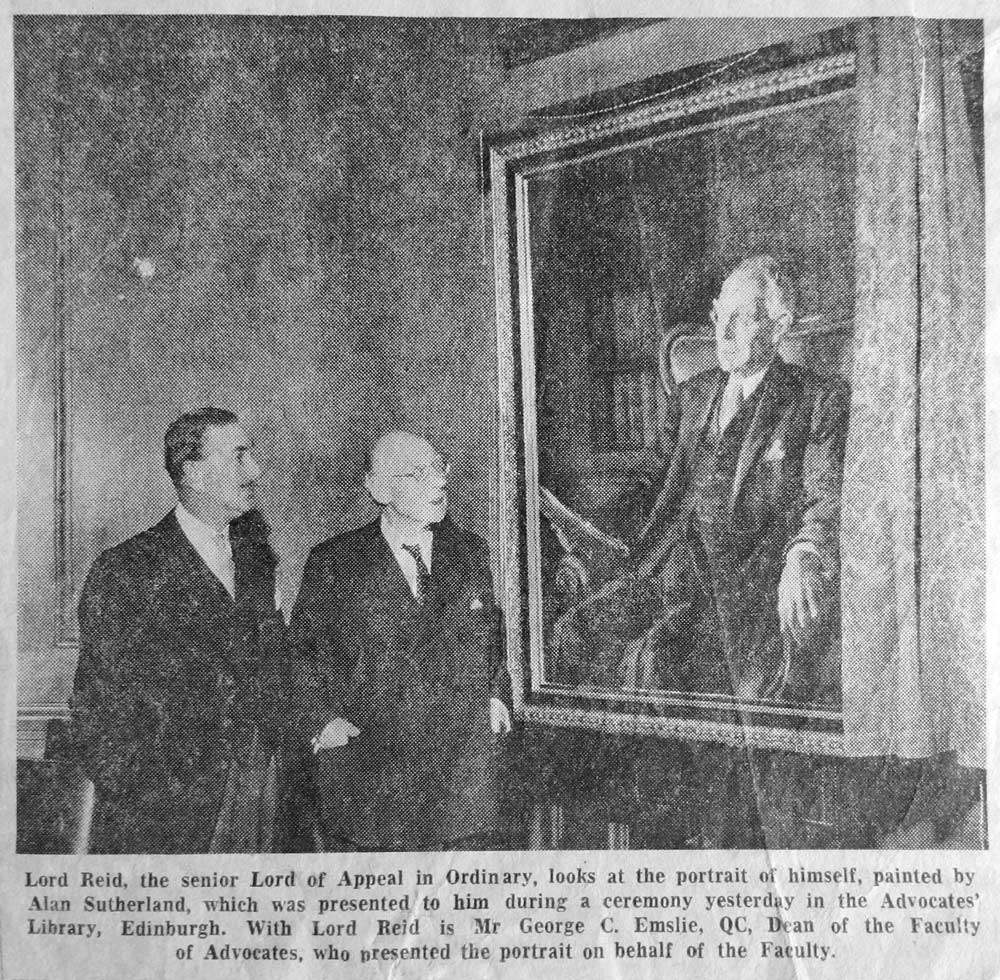 Portrait presentation - Lord Reid
The Scotsman | 1970
Portrait presentation - Lord Reid
The Scotsman | 1970
 Top Artist Makes Home in Wingham
Sydney Morning Herald | 1976
Top Artist Makes Home in Wingham
Sydney Morning Herald | 1976
 Paintings on Show
Wingham Chronicle | 1977
Paintings on Show
Wingham Chronicle | 1977
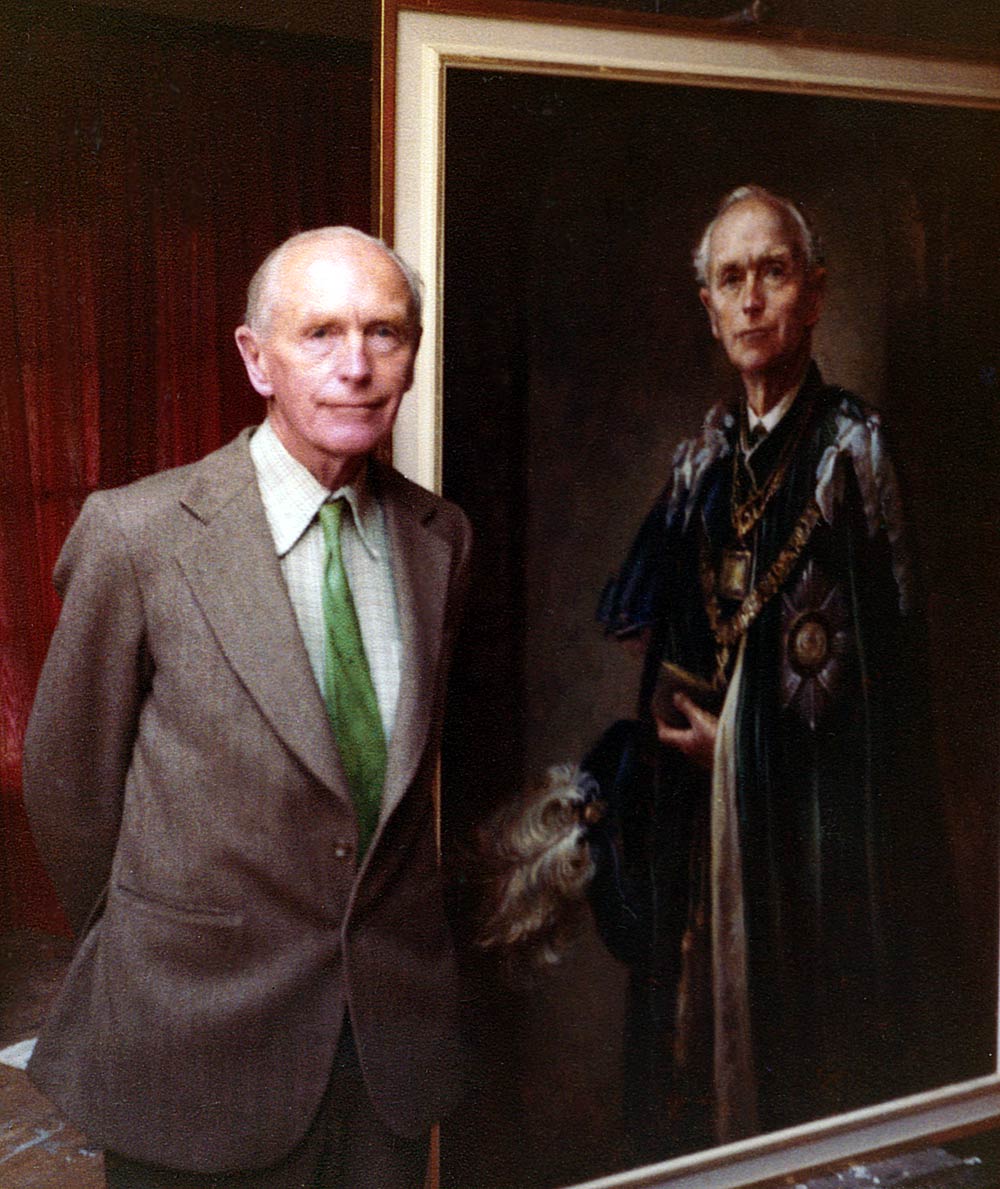 Lord Alec Douglas-Home
Hirsel | 1979
Lord Alec Douglas-Home
Hirsel | 1979
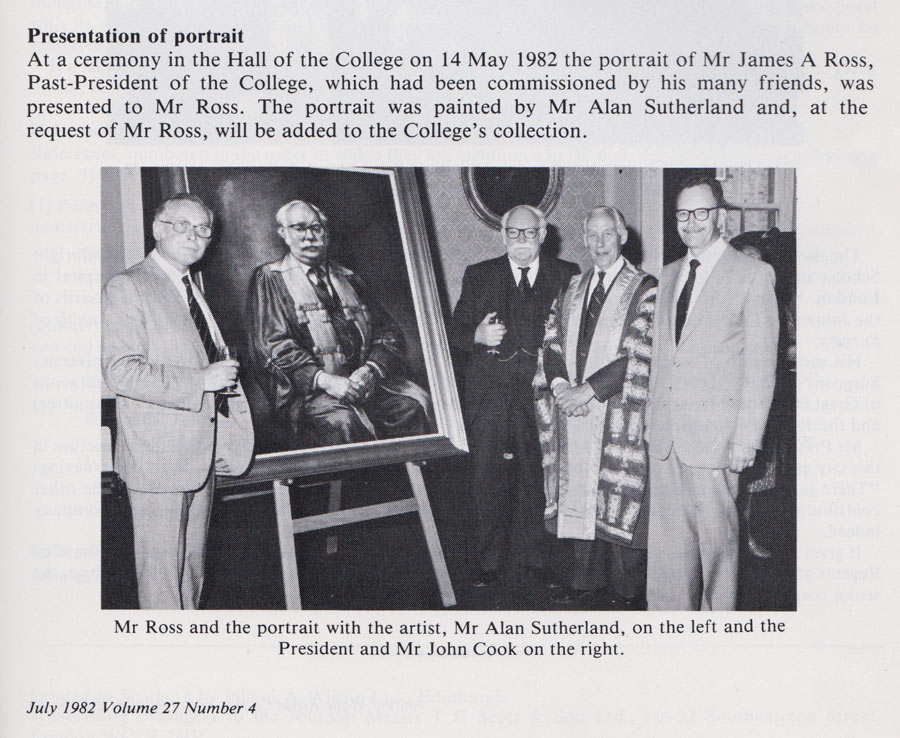 Portrait presentation - James Ross
Journal of the Royal College of Surgeons of Edinburgh | 1982
Portrait presentation - James Ross
Journal of the Royal College of Surgeons of Edinburgh | 1982
 Artist in Studio
1982
Artist in Studio
1982
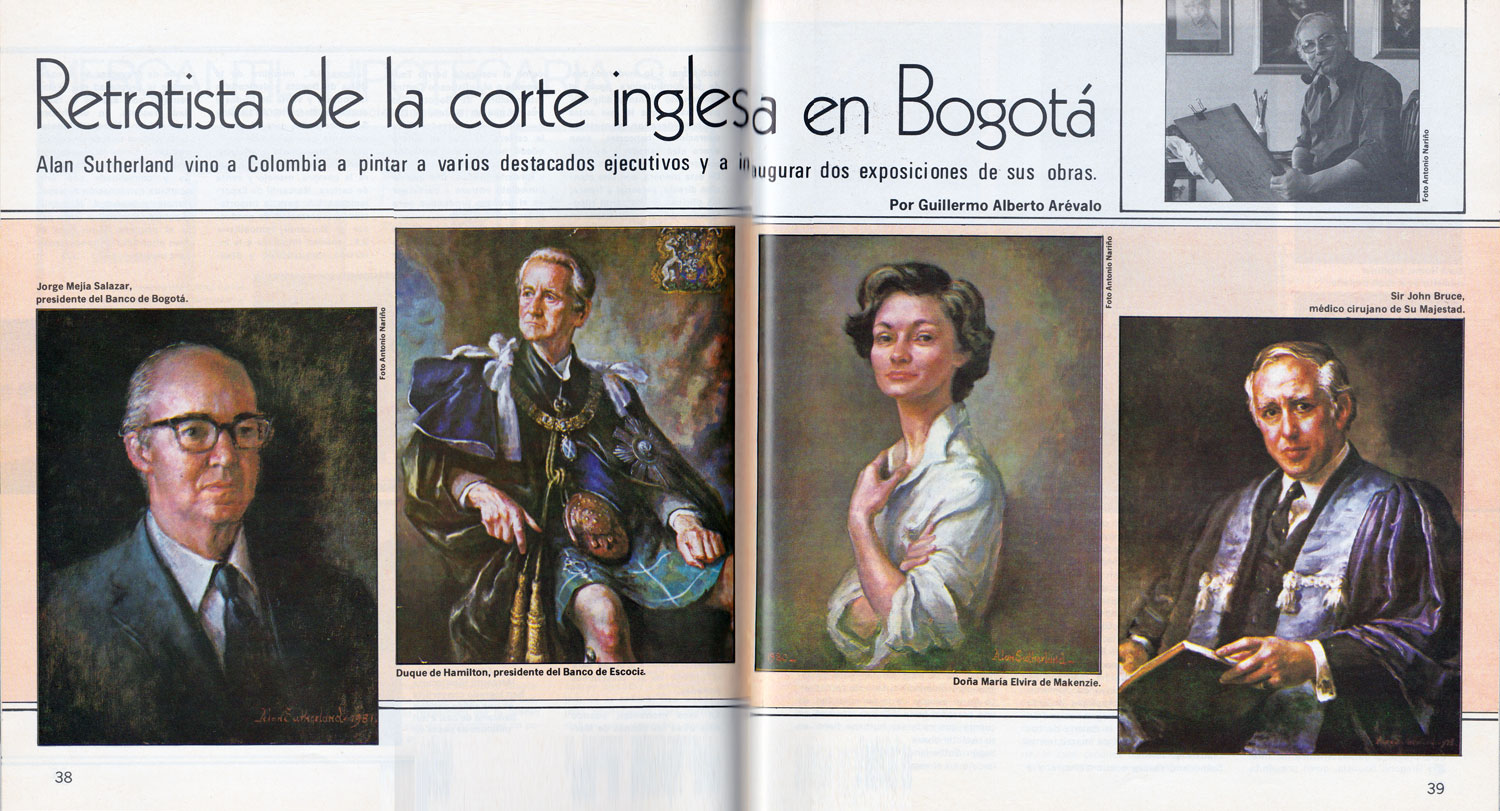
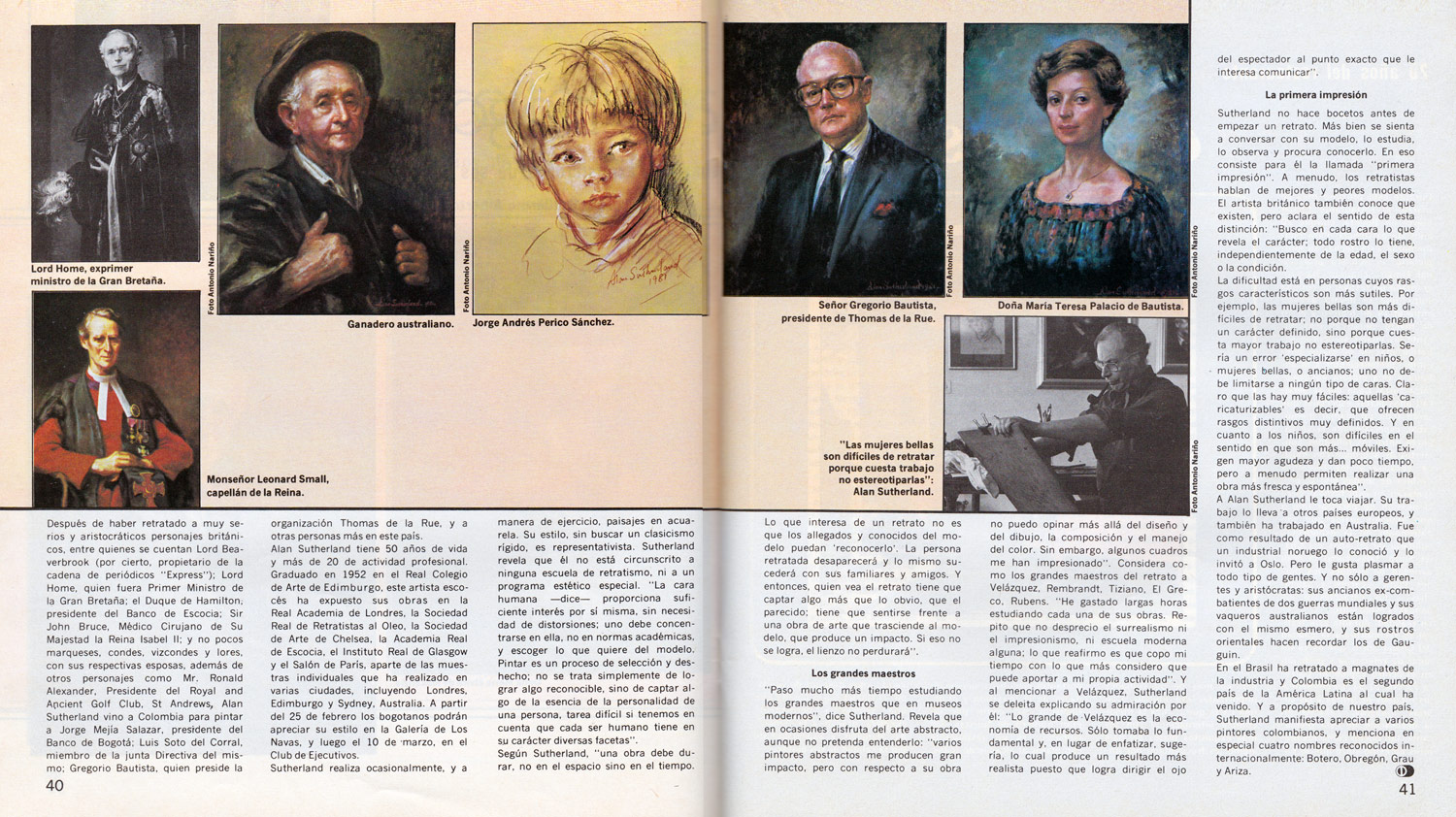 Retratista de la corte inglesa en Bogotá
Revista Diners | Colombia | Febrero de 1982
Retratista de la corte inglesa en Bogotá
Revista Diners | Colombia | Febrero de 1982
- A British Portrait Painter in Bogotá
After painting the portraits of several important British aristocrats, including Lord Beaverbrook (owner of the "Express" newspaper); Lord Home, former Prime Minister of Great Britain; the Duke of Hamilton; BNCO president of Scotland; Sir John Bruce, Surgeon of Her Majesty Queen Elizabeth II; not to mention a few marquises, earls, viscounts and lords, their wives, and others including Mr Ronald Alexander, President of the Royal and Ancient Golf Club, St Andrews, Alan Sutherland has come to Colombia to paint Jorge Salazar Mejia, president of Banco de Bogotá: Luis Soto del Corral, member of its Board of Directors; Gregorio Bautista, who chairs the organization Thomas de la Rue, and others in this country.
Alan Sutherland is 50 years old with a professional career spanning more than 20 years. Since graduating in 1952 at the Royal College of Art in Edinburgh, this Scottish artist has exhibited at the Royal Academy in London, the Royal Society of Portrait Painters, the Chelsea Art Society, the Royal Scottish Academy, the Royal Institute Glasgow and the Salon de Paris, in addition to exhibiting one-man shows in several cities, including London, Edinburgh and Sydney, Australia. From 25 February the public can admire his work at Gallery Los Navas, then from March 10, in the Executive Club.
Sutherland occasionally paints landscapes in watercolour as an exercise. His style, without wishing to categorise it, is primarily representational. Sutherland reveals that he is not confined to any particular school of portraiture or type of aesthetic. "The human face, he says, is fascinating enough in itself, without the need to distort it: one must concentrate on it first and foremost, not on any academic standards, and choose what one wants from the subject. Painting is a process of selection and disposal; it is not simply a question of achieving a good likeness, but to capture something of the essence of the person's personality, a difficult task when we consider that everyone has many facets to their character."
According to Sutherland, "a work should last, not in space but in time. What matters is not just producing a portrait which the relatives and acquaintances of the subject can 'recognize'. The sitter wont be around forever - likewise their family and friends. The portrait has to capture something more than the obvious, than just the resemblance, so that anyone can appreciate it; a work of art must transcend the model to create an impact. If this is not achieved, the painting will not endure."
The Old Masters
"I spend a lot of time studying the old masters in modern museums," says Sutherland. He reveals that he enjoys some abstract art but makes no pretence to understanding it: "several abstract painters produce quite an impact, but with regards to their work I can't really comment beyond the design and drawing, composition and use of colour. Some of the frames are impressive though. " Concerning the great portrait painters Velazquez, Rembrandt, Titian, El Greco, Rubens: "I have spent a long time studying each of their works. I should emphasise that I don't dislike surrealism or impressionism or any modern school; I just devote more of my time to what I believe I can learn more from." And with the mention of Velazquez, Sutherland is keen to express his admiration for "The great use of economy that Velazquez employs. He only take the bare essentials and then either emphasizes or suggests, which produces a more realistic result since it succeeds in leading the viewer's eye to the exact spot you are interested in communicating."
The First Impression
Sutherland tends not to make sketches before starting a portrait. Instead he will sit down and have a chat with the subject in order to study and observe their character - to get to know them. This is for the “first impression”. Portrait artists often talk of good and bad models. The British artist acknowledges this but clarifies the meaning of this distinction. "I try and glimpse something of their character from their face: it’s in everyone’s face, regardless of age, sex or condition.
It’s harder to find with people with more subtle features. For example, attractive women can be more difficult to portray; not because they have a striking look, but because it requires more effort to see beyond this. It would be a mistake to 'specialize' in children, or beautiful women, or the elderly; one should not be limited to any type of face. Certainly some are easier: ‘caricature-like faces” ie those with very distinctive, pronounced features. As for children, they are difficult because they move a lot. They require a degree of vigilance so you don’t get so much time, however this can often result in a picture that's more fresh and spontaneous".
Alan Sutherland is well travelled. His job has taken him around Europe, and he has also worked in Australia. It was as a result of a self-portrait that he met an influential Norwegian who invited him to work in Oslo. But he is happy to paint all kinds of people. It’s not only big business owners and aristocrats: an aging veteran of two world wars and an Australian bushman are painted with the same care, and the oriental faces are reminiscent of Gauguin.
In Brazil he has portrayed captains of industry and Columbia is the second country in Latin America he has visited. With regards to here, Sutherland says he is very keen on several Colombian painters, particularly these four internationally recognised artists: Botero, Obregón, Grau and Ariza.
 Un "Cazador" de la naturaleza humana
El Tiempo | 1982
Un "Cazador" de la naturaleza humana
El Tiempo | 1982
- A "Hunter" of Human Nature
Each time that Alan Sutherland is commissioned to paint a portrait, the price of which varies between 100 and 400 thousand pesos, he embarks on a detailed process of observation, studying the pores, gestures, hairs, the irregularities of the face, the shaping of the lips, eyes, colour and expression; an attempt to search for the soul of an individual through the outward manifestations of his temperament.
It's quite a task, but Sutherland – born in the UK and now 50 years old - believes that it is the best job in the world, not only because it has led to travel throughout Europe, South America and Australia, but also, he has learned almost everything about human nature.
He doesn't speak Spanish but his English is so crisp and clear, that although I couldn't understand a word he said, I felt compelled to respond "yes" all the time, as he seemed so compelling. A translator facilitated this interview.
Observation and Technique
For 50 years, Sutherland has produced portraits on canvas from Lords, Dukes, Marquises, Premieres, bankers, Viscounts, Counts, Admirals, Sires, usually in four two-hour sessions "with many intervals and a lot of coffee."
"My personal process is to observe the subject, their physical attributes and as much as I can of their character traits" says Mr Sutherland describing his craft. Each sentence is slow, emphasising his points with much gesticulation.
"Spending a lot of time trying to know the person is the most important part, it’s during this time that I formulate what I want to do. This first process, it is mental, the second, the painting, is purely technical. But the first is the more important, since one should always have enough technical ability to express the message.”
"Learning About Myself"
Sutherland’s decision to devote his life to painting portraits, after graduating in 1952 at the Royal College of Art in Edinburgh and completing postgraduate studies in Italy and France, is something I can identify with. "I'm interested in exploring a person's character”, says Sutherland, “and expressing my emotional response through the painting." Life has thrown him into the path of a variety of characters, many of whom have become his best friends. "It's like learning about myself” he adds.
Eccentric Clients
Is a friendship established between the painter and the subject in the process of a portrait?
“You expect some kind of connection. I can work well if the relationship is harmonious, but sometimes the opposite happens and I’ve wished that someone else had been asked to do the drawing. If this happens, I do not think a brush should be used as a weapon, distorting the picture. A painter must always give the portrait a level of dignity, because a "cruel" portrait cannot be forgiven.”
"I have painted murals at a price of 4 thousand pounds sterling, I produced a very large mural that had 36 figures - an eccentric millionaire in Scotland asked me to paint nudes on his ceiling. I obliged, with apologies to Michelangelo. "When I looked at the ceiling I had no idea how it would turn out," he says smiling through his big sunglasses, "but it worked in the end. (fortunately Michelangelo wasn't there to comment). "
A Story
How do you feel when one of the characters you have painted dies?
“This portrait,” says Sutherland pointing to a photograph of one of his oils, “is of a Mayor of Edinburgh, which was painted for the city. He was a great friend of mine, an elderly gentleman with a younger wife. He got into financial problems and one day, he and his young wife committed suicide. It was tragic.”
My question was referring to the idea that you can “touch” a portrait, so in a sense they have been “immortalized” with the brush. When they die the portrait takes on a greater significance.
“I think a good portrait” says Mr Sutherland, gesturing with his pipe, “should last over time, and for that to happen you must have more than just a resemblance, because when the subject is no longer with us, nor their friends or relatives, it should have something of interest for posterity, for people who never met, nor cared about them. What makes that last over time must be something deeper.”
“Duncan McKenzie, an old family friend, had some time ago brought some photos of portraits of his which created some interest in Columbia. During his first trip here he painted the president of the Bank of Bogota, Jorge Salazar Mejia, Dr. Luis Soto del Corral and President of Thomas de la Rue, Dr. Gregory and Mrs. Bautista. This time he is visiting Santander where he will be working on some portraits this week.”
Back and forth, Alan Sutherland travels the world, not guessing on the future of his clients, but seeking to know something of their past, and capturing it in a portrait for anywhere between one hundred thousand to 400 thousand pesos.
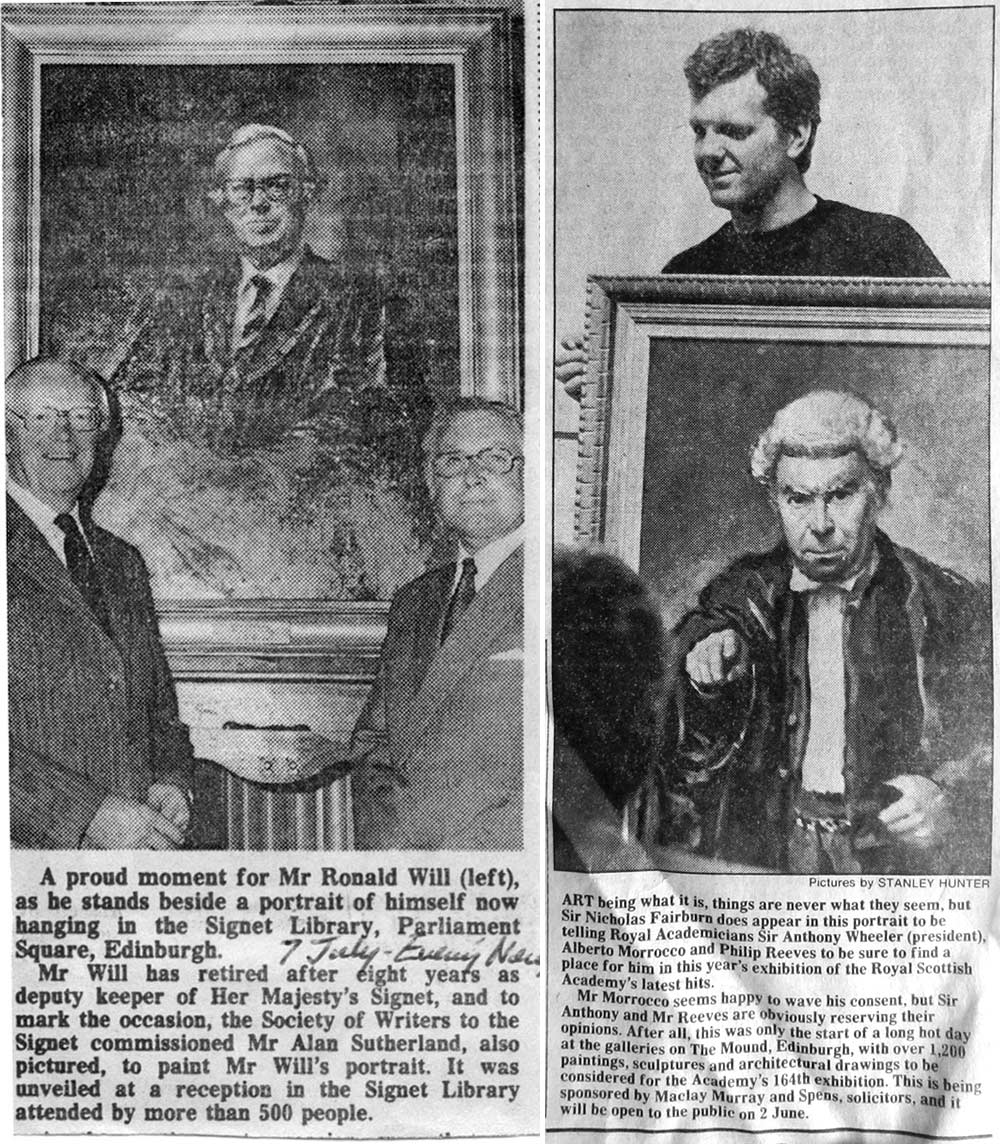 Ronald Will / RSA Exhibition
Edinburgh Evening News | 1983
Ronald Will / RSA Exhibition
Edinburgh Evening News | 1983
 Portrait presentation - Ronald Will
Scottish Field | 1983
Portrait presentation - Ronald Will
Scottish Field | 1983
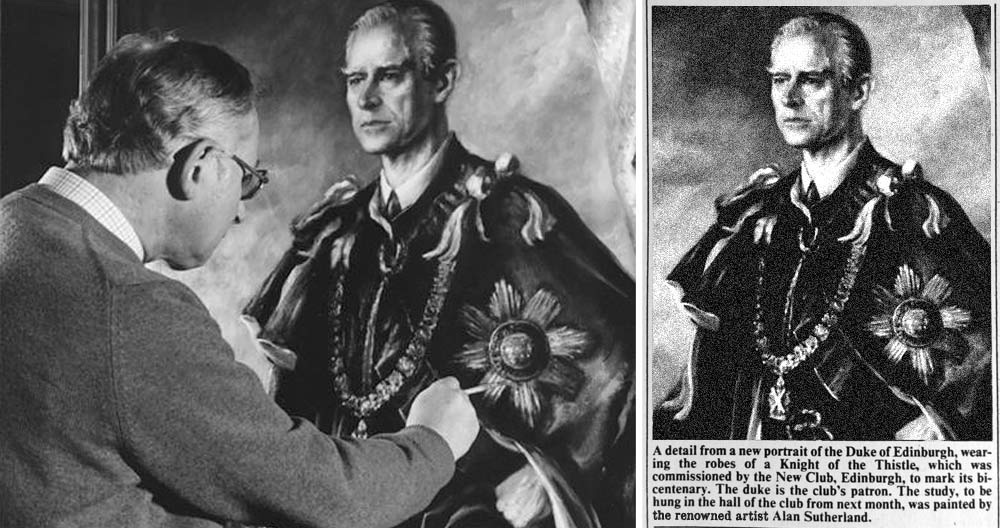 Prince Philip Portrait
Holyrood Palace | 1987
Prince Philip Portrait
Holyrood Palace | 1987
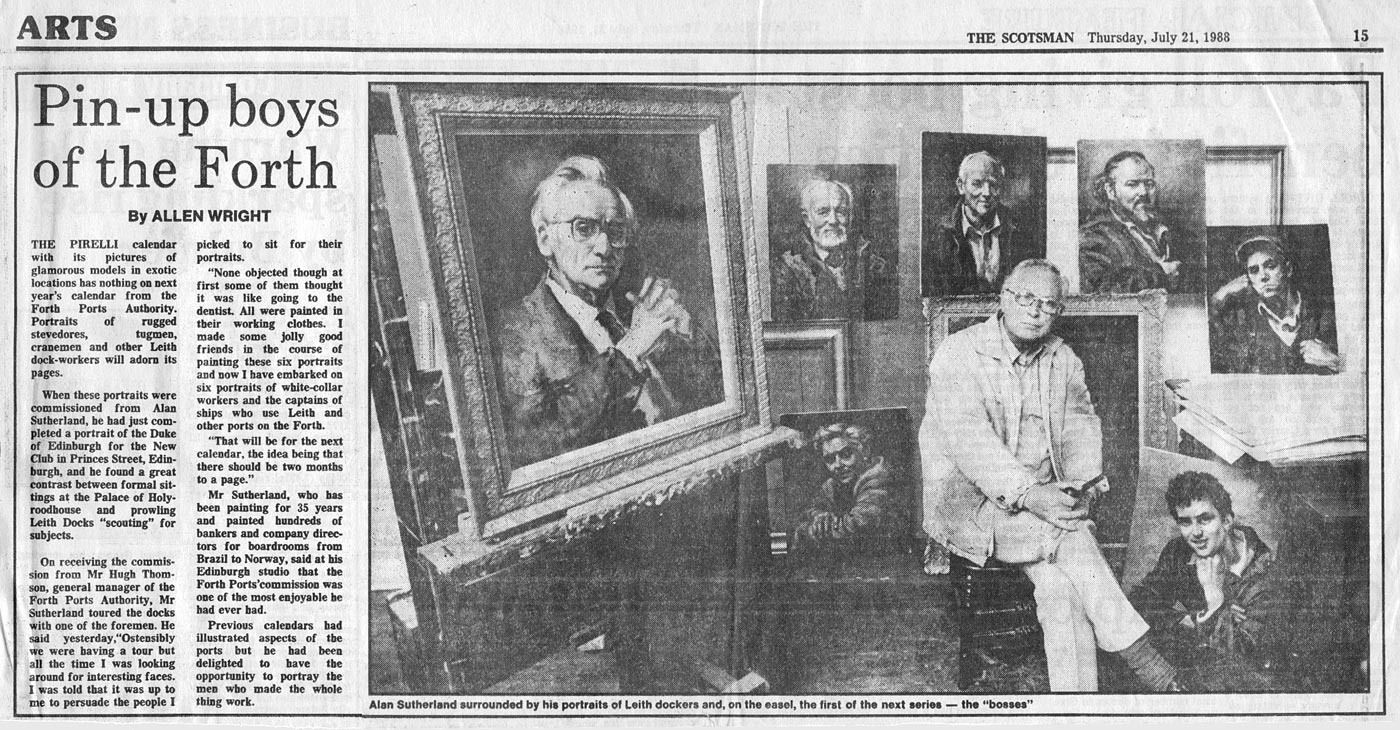 Pin-up boys of the Forth
The Scotsman | 1988
Pin-up boys of the Forth
The Scotsman | 1988
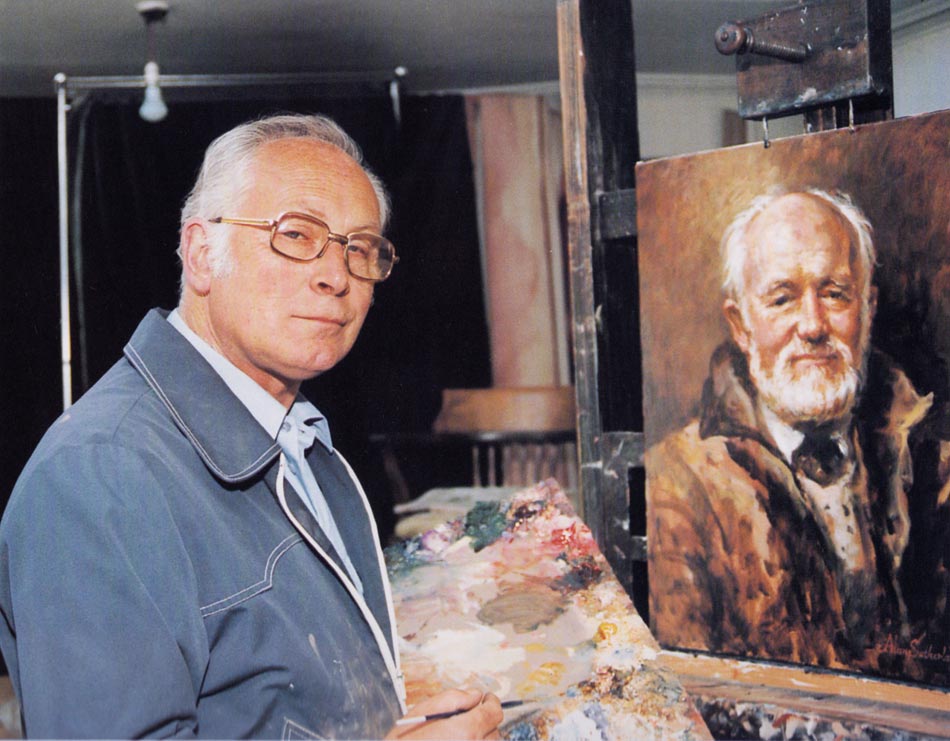 At the Easel
Forth Ports Calendar Cover Photo | 1988
At the Easel
Forth Ports Calendar Cover Photo | 1988
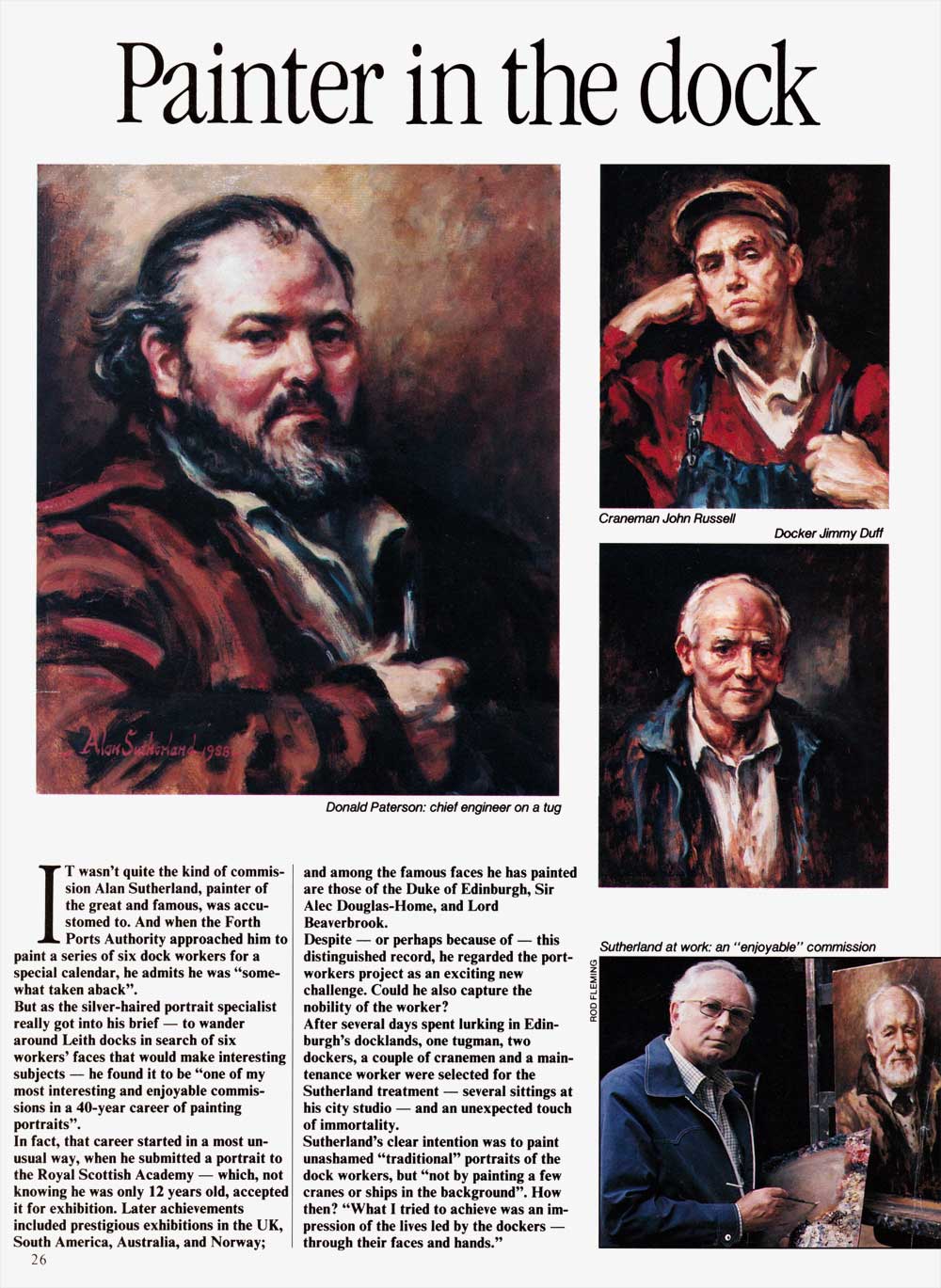 Painter in the Dock
Scotsman Magazine | 1988
Painter in the Dock
Scotsman Magazine | 1988
 Pirelli Potential?
Forthlink Magazine | 1988
Pirelli Potential?
Forthlink Magazine | 1988
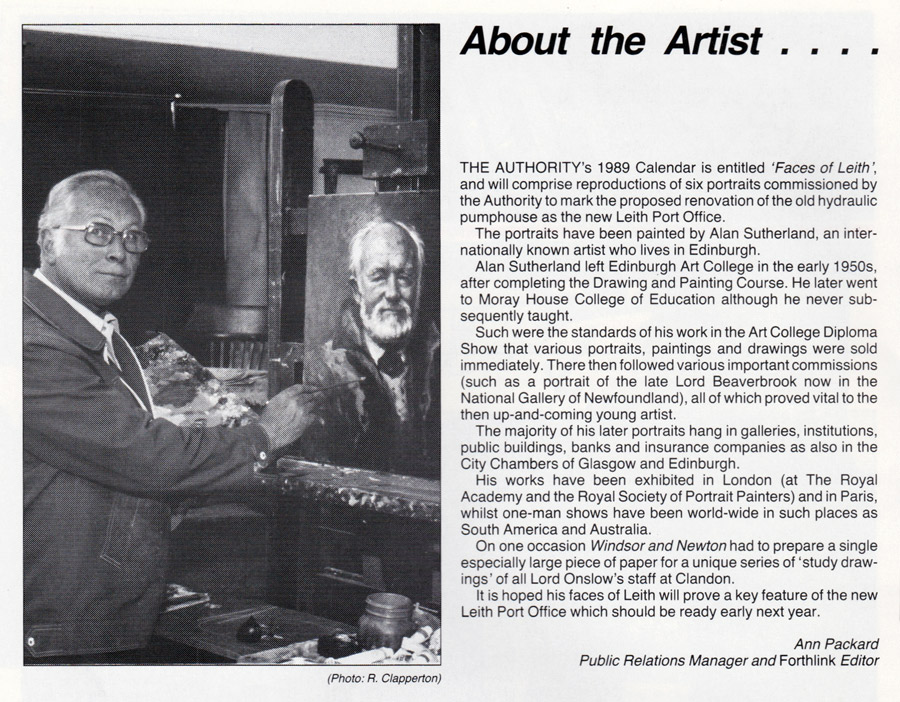 About the Artist...
Forthlink Magazine | 1988
About the Artist...
Forthlink Magazine | 1988
 With Robert Evans and portrait (unfinished)
Beverly Hills | 1989
With Robert Evans and portrait (unfinished)
Beverly Hills | 1989
 Letter from Margaret Thatcher
House of Commons | 1991
Letter from Margaret Thatcher
House of Commons | 1991
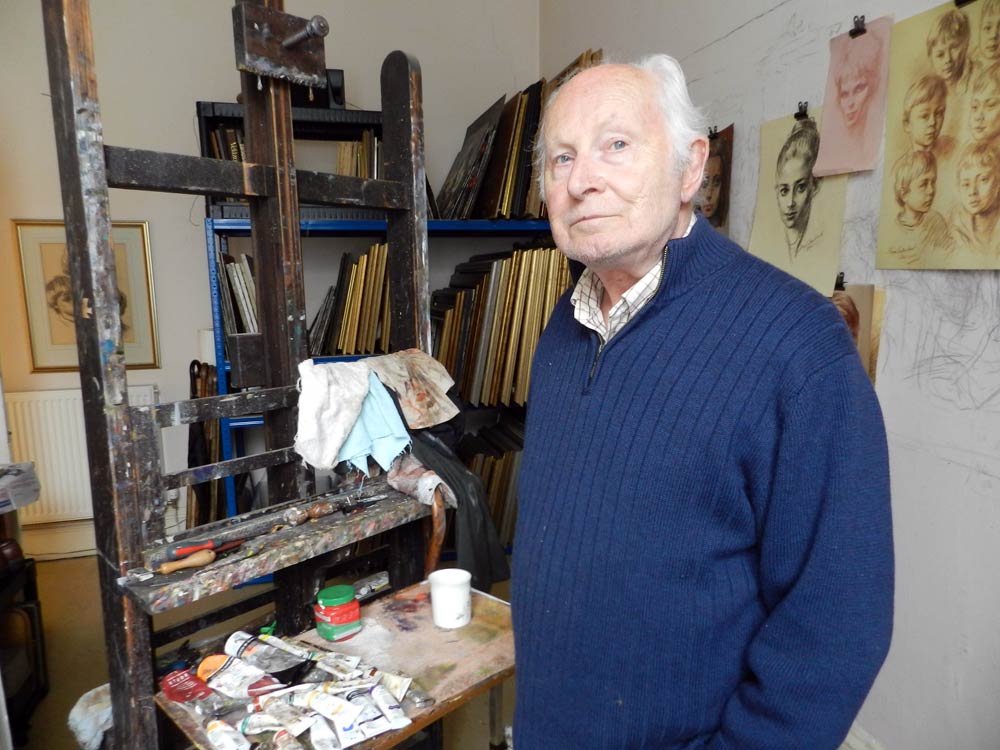 Studio
Edinburgh | 2014
Studio
Edinburgh | 2014

